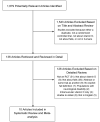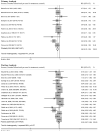Vitamin D treatment for the prevention of falls in older adults: systematic review and meta-analysis
- PMID: 20579169
- PMCID: PMC3125705
- DOI: 10.1111/j.1532-5415.2010.02949.x
Vitamin D treatment for the prevention of falls in older adults: systematic review and meta-analysis
Abstract
Objectives: To systematically review and quantitatively synthesize the effect of vitamin D therapy on fall prevention in older adults.
Design: Systematic review and meta-analysis.
Setting: MEDLINE, CINAHL, Web of Science, EMBASE, Cochrane Library, LILACS, bibliographies of selected articles, and previous systematic reviews through February 2009 were searched for eligible studies.
Participants: Older adults (aged > or = 60) who participated in randomized controlled trials that both investigated the effectiveness of vitamin D therapy in the prevention of falls and used an explicit fall definition.
Measurements: Two authors independently extracted data, including study characteristics, quality assessment, and outcomes. The I(2) statistic was used to assess heterogeneity in a random-effects model.
Results: Of 1,679 potentially relevant articles, 10 met inclusion criteria. In pooled analysis, vitamin D therapy (200-1,000 IU) resulted in 14% (relative risk (RR)=0.86, 95% confidence interval (CI)=0.79-0.93; I(2)=7%) fewer falls than calcium or placebo (number needed to treat =15). The following subgroups had significantly fewer falls: community-dwelling (aged <80), adjunctive calcium supplementation, no history of fractures or falls, duration longer than 6 months, cholecalciferol, and dose of 800 IU or greater. Meta-regression demonstrated no linear association between vitamin D dose or duration and treatment effect. Post hoc analysis including seven additional studies (17 total) without explicit fall definitions yielded smaller benefit (RR=0.92, 95% CI=0.87-0.98) and more heterogeneity (I(2)=36%) but found significant intergroup differences favoring adjunctive calcium over none (P=.001).
Conclusion: Vitamin D treatment effectively reduces the risk of falls in older adults. Future studies should investigate whether particular populations or treatment regimens may have greater benefit.
Figures


Comment in
-
Vitamin D reduces the risk of falls in older adults compared with calcium or placebo.Evid Based Nurs. 2011 Apr;14(2):38-9. doi: 10.1136/ebn.14.2.38. Evid Based Nurs. 2011. PMID: 21421967 No abstract available.
Similar articles
-
Folic acid supplementation and malaria susceptibility and severity among people taking antifolate antimalarial drugs in endemic areas.Cochrane Database Syst Rev. 2022 Feb 1;2(2022):CD014217. doi: 10.1002/14651858.CD014217. Cochrane Database Syst Rev. 2022. PMID: 36321557 Free PMC article.
-
Effect of vitamin D, calcium, or combined supplementation on fall prevention: a systematic review and updated network meta-analysis.BMC Geriatr. 2024 May 2;24(1):390. doi: 10.1186/s12877-024-05009-x. BMC Geriatr. 2024. PMID: 38698349 Free PMC article.
-
Effectiveness and safety of vitamin D in relation to bone health.Evid Rep Technol Assess (Full Rep). 2007 Aug;(158):1-235. Evid Rep Technol Assess (Full Rep). 2007. PMID: 18088161 Free PMC article. Review.
-
Vitamin D supplementation reduces the risk of fall in the vitamin D deficient elderly: An updated meta-analysis.Clin Nutr. 2021 Nov;40(11):5531-5537. doi: 10.1016/j.clnu.2021.09.031. Epub 2021 Sep 27. Clin Nutr. 2021. PMID: 34656949
-
Interventions to Prevent Falls in Older Adults: Updated Evidence Report and Systematic Review for the US Preventive Services Task Force.JAMA. 2018 Apr 24;319(16):1705-1716. doi: 10.1001/jama.2017.21962. JAMA. 2018. PMID: 29710140 Review.
Cited by
-
Comparison of cost-effectiveness of vitamin D screening with that of universal supplementation in preventing falls in community-dwelling older adults.J Am Geriatr Soc. 2013 May;61(5):707-14. doi: 10.1111/jgs.12213. Epub 2013 Apr 30. J Am Geriatr Soc. 2013. PMID: 23631393 Free PMC article.
-
Association between sarcopenia grade and fall history among older adults in West China: A retrospective study.BMJ Open. 2024 Feb 20;14(2):e080426. doi: 10.1136/bmjopen-2023-080426. BMJ Open. 2024. PMID: 38382964 Free PMC article.
-
Office management of gait disorders in the elderly.Can Fam Physician. 2011 Jul;57(7):765-70. Can Fam Physician. 2011. PMID: 21753097 Free PMC article. Review.
-
Vitamin D supplementation and its influence on muscle strength and mobility in community-dwelling older persons: a systematic review and meta-analysis.J Hum Nutr Diet. 2017 Feb;30(1):3-15. doi: 10.1111/jhn.12394. Epub 2016 Jul 27. J Hum Nutr Diet. 2017. PMID: 27460044 Free PMC article. Review.
-
Prevalence of Vitamin D Deficiency Amongst Indian Orthopaedic Surgeons.Indian J Orthop. 2020 May 14;54(Suppl 1):183-187. doi: 10.1007/s43465-020-00134-2. eCollection 2020 Sep. Indian J Orthop. 2020. PMID: 32952928 Free PMC article.
References
-
- Campbell AJ, Borrie MJ, Spears GF, Jackson SL, et al. Circumstances and consequences of falls experienced by a community population 70 years and over during a prospective study. Age Ageing. 1990;19:136–141. - PubMed
-
- Blake AJ, Morgan K, Bendall MJ, et al. Falls by elderly people at home: Prevalence and associated factors. Age Ageing. 1988;17:365–372. - PubMed
-
- Prudham D, Evans JG. Factors associated with falls in the elderly: A community study. Age Ageing. 1981;10:141–146. - PubMed
-
- Tinetti ME, Williams CS. The effect of falls and fall injuries on functioning in community-dwelling older persons. J Gerontol A Biol Sci Med Sci. 1998;53:M112–119. - PubMed
-
- Gillespie LD, Gillespie WJ, Robertson MC, et al. Interventions for preventing falls in elderly people. Cochrane Database Syst Rev. 2003;4 CD000340. - PubMed
Publication types
MeSH terms
Substances
Grants and funding
LinkOut - more resources
Full Text Sources
Medical
Miscellaneous

